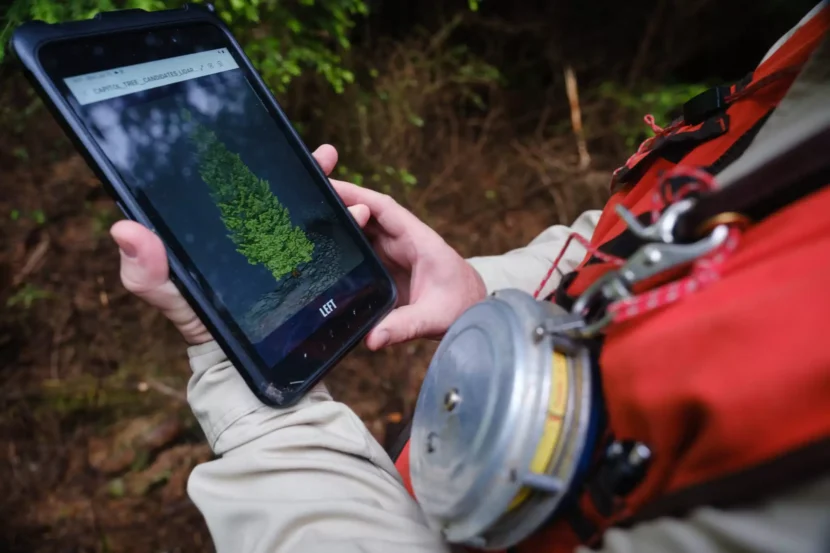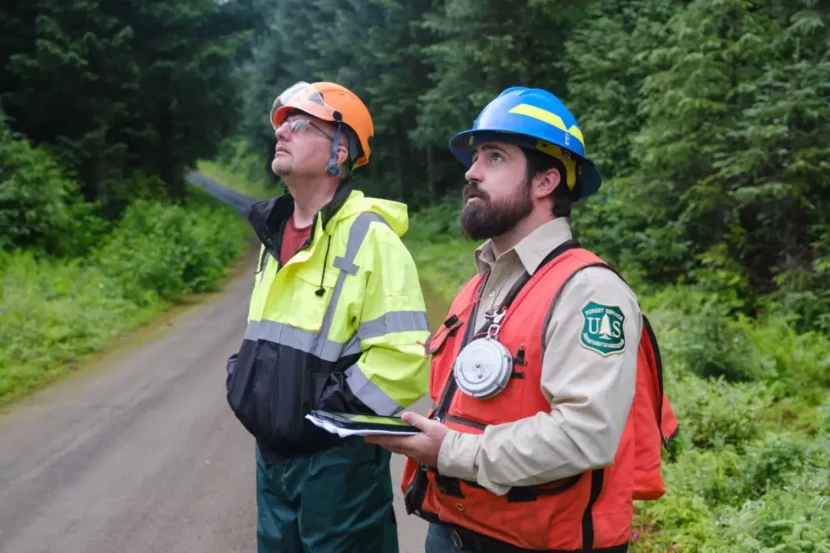
A tree from Southeast Alaska’s Tongass National Forest has been chosen for this year’s Capitol Christmas Tree near the White House.
Last month, the U.S. Forest Service and D.C. officials met in Wrangell to decide which one will become “The People’s Tree,” gracing the grounds of the Capitol lawn.
Not only will the tree represent Alaska, but it also will symbolize the Tongass’s people, history and culture.
Jim Kaufman, with the Architect of the Capitol, was one of the officials who looked for the perfect tree from Wrangell and surrounding islands. The legislative branch oversees the grounds and landmark buildings of Capitol Hill in Washington, D.C.
He said learning about the temperate rainforest and the people in Southeast Alaska helps him decide on the tree. So he first met some locals.
“Understanding what really makes the local people of the Tongass and the history,” Kaufman said. “It’s a piece of the people that it comes from, the local people, that then get taken to the United States Capitol where people from around the world will learn about these regions that many people won’t be able to ever see.”
Kaufman said it’s a very tedious process picking out the “The People’s Tree” to represent our nation. But one thing is clear – it can’t be small.
“When I picture Alaska, and what the general person thinks of Alaska, is big,” he said. “That’s what these trees are, are big. Big sweeping branches, a full tree.”
The Tongass is expansive – nearly 17 million acres – and remote, with limited roads on the region’s islands. The Forest Service has kept tabs on certain “supreme” tree candidates to help Kaufman’s task be more manageable.
“I’m able to look at the candidate trees and really start to see, ‘is it the right height?’ So is it somewhere between 50 and 75 feet high?,” he said. “That’s one of the things I start to look at, and then how wide. We really want something in that 25, maybe 30-foot range.”
He said that the tree has to look good from every angle, 360 degrees around. On top of that, they also had to think about logistics, like how the tree will be transported and how it will fit onto the tractor trailer.
They’re looking for a Sitka Spruce because it’s the predominant species of the Tongass. But even each spruce tree is unique. And some characteristics make it more hardy.
“How thick are the branches? So are they three inches thick? How easy and how flexible are they going to be to be transported? But then we still want some stiffness to those branches so that all the handmade ornaments that all the people of Tongass are making can really be secured firmly and hold up,” Kaufman said.
He said all of these factors make his job difficult.
“That’s the fun challenge,” Kaufman said. “It was a little stressful. I know we can’t go wrong because we have such a strong quality pool here of candidates.”

Tom Roland, a silviculturist in the Chugach National Forest, has been assisting Kaufman. He serves as the tree team lead for the Capitol Christmas Tree. Basically, he manages everything from the selection of candidates to harvest and transportation. He said they had five to six days of touring the selected candidates.
Roland said that the process of selecting trees started about a year ago.
They looked in the Chugach and Tongass, but ended up focusing specifically in the Wrangell district of the Tongass. “The People’s Tree” in 2015 was from the Chugach.
He said that they mainly relied on personnel on the ground to select a tree, but they did use a variety of other technologies.
“We did obtain drone footage of a few of our candidates,” Roland said. “T3 was involved in that effort.”
T3 is an organization for high schoolers that focus on STEM projects, like this one.
The Forest Service and its partners modeled individual characteristics with aerial-based LIDAR for over 13.5 million trees. The ground based LIDAR allowed them to decide which trees were top candidates.
Roland said selecting a tree from the Tongass was a very unique process.
“This is the first Capitol Christmas Tree effort that involves boats and barges,” he said. “So that’s been a real experience.”
The U.S. Capitol has had a Christmas Tree from a National Forest on its lawn since 1970. “The People’s Tree” rotates between the nation’s nine U.S. Forest Service regions. So it was region 10’s turn here in Alaska. Interestingly, there is no Region 7 because they consolidated it into other regions several years ago.
He said that Kaufman has to select two trees, one being the primary and then a second one in case something happens to the first, like bad weather.
They’ll join the tree for an approximately 20-day whistle stop tour, visiting communities across the Lower 48. They’ll also make sure the tree is healthy enough to make the trip, especially on the barge down to Washington state.
“We’re really having to be innovative in that process as well, trying to keep a tree green and in good shape for that long prior to getting to the Capitol,” Roland said. “Once it’s to the Capitol, it’s on display for close to a month as well. So that’s a long time to keep a tree green and in good shape.”
Even cutting down the tree is complex.
“It’s a very big process,” Roland said. “We want to make sure that the tree isn’t damaged. And so even the act of getting the tree off the landscape is very complex. It usually involves a crane or to some excavators a very large truck and it can take upwards of a day to get the tree from the stump and onto the truck.”
Brandon Raile, who’s also with the Chugach National Forest and taking a lead on the project, said they’ve been in planning mode for the past year with finding candidates and figuring out logistics. But the process is picking up speed now.
“Once the Architect of the Capitol’s office is out here and makes the tree selection, then it’s like, we’re in that roller coaster that’s just crested the top and it’s getting ready to go down faster and faster,” he said. “So this is a really exciting time for us. It’s been a lot of fun.”
Raile said that showing the Tongass to the D.C. folks has been enjoyable time to him.
“Being an Alaskan, I love seeing the looks on people’s faces that aren’t from Alaska when they come to Alaska for the first time,” he said. “So it was very, very cool to see that amazement, that wonder, you know, on our guests faces.”
Raile said that whatever tree that Kaufman picks is going to be amazing. He agreed that each tree has different characteristics.
“Just like people, they each have their own unique little characteristics that make them special,” he said.
He said everyone on his team with the National Forest Service was sizing up each tree they saw. He said because of this experience he’ll probably be super picky about Christmas trees for the rest of his life.
“Apparently I’m not a very good judge of tree height,” Raile said. “So all the ones that I sent in very enthusiastically, like, ‘Hey, what about this candidate?’ They came back and said, ‘No, that’s too small.’”
Kaufman eventually did pick the 2024 “People’s Tree,” though the exact location is top secret. What we do know is that it currently resides on Wrangell Island.

